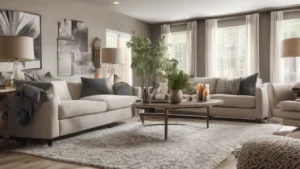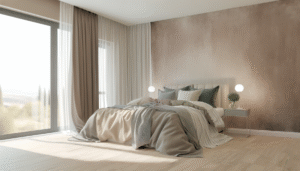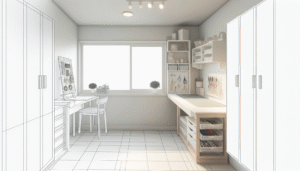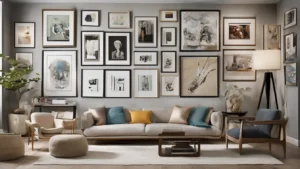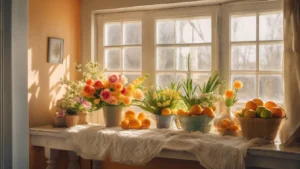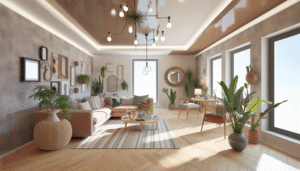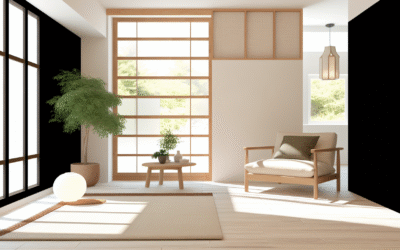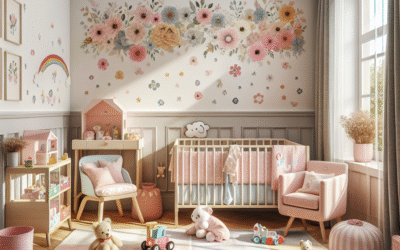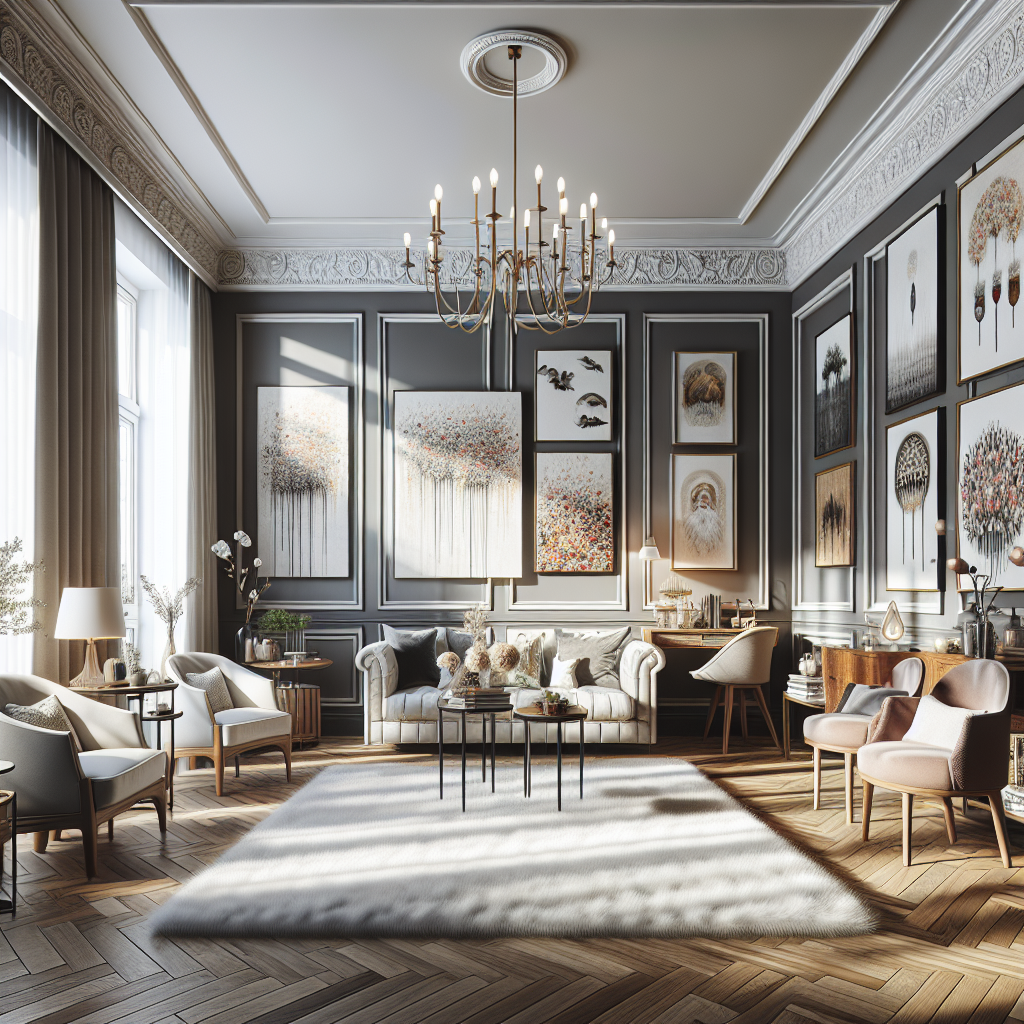
Ever walked into a room and felt instantly drawn to one particular spot? Chances are, that’s the magic of a well-placed focal point, and wall art is often the star of the show. It’s not just about slapping a picture on the wall; it’s about creating a visual narrative that enhances your space and reflects your personality. So, how do we achieve this effortless style? Let’s get into it.
What Makes a Good Focal Point Anyway?
So, what really makes a space grab your attention right away? Think of it as the “wow” factor, right? The element that naturally draws your eyes and sets the tone for the entire room: a piece of wall art can achieve that—and then some. Color, size, and placement all play a huge role. A large, vibrant painting in a neutral room? Definitely a focal point. A gallery wall above a sofa? Absolutely. But it’s not just about the visual impact. Emotional connection matters too. The focal point should resonate with you, tell a story, or evoke a feeling. After all, it’s going to be the star of the show!
Why Wall Art is Your Secret Weapon
Why are we so hyped about wall art as the ultimate focal point? Because it’s versatile, impactful, and totally customizable. Wallpaper is so passé. Prints, paintings, sculptures – you name it! Unlike furniture or architectural features, wall art can be easily swapped out to reflect changing tastes or seasonal vibes. Plus, it’s a fantastic way to inject color, texture, and personality into a space without committing to major renovations. It is also relatively inexpensive when compared to a major construction or build; and you can take it with you when you relocate! You know what? That makes wall art investment-worthy, honestly!
Picking the Perfect Piece: Size, Color, and Subject Matter
Okay, let’s talk specifics. How do you actually pick the right piece of wall art? Size is crucial. A tiny print on a vast wall will look awkward, while an oversized piece in a small room can feel overwhelming. As a general rule, the art should be about two-thirds to three-quarters the width of the furniture it’s hanging above. Got a long sofa? Go for a wider piece or a gallery arrangement. Then there’s color. Do you want the art to blend in or pop? Complementary colors create harmony, while contrasting colors add drama. And subject matter? That’s totally personal. Abstract art? Landscapes? Portraits? Choose something that speaks to you. It’s your space, after all!
The Art of Placement: Height, Spacing, and Symmetry
So, where do you hang that masterpiece? Placement is key (duh!), guys. A good rule of thumb is to hang art at eye level. For most people, that’s about 57 to 60 inches from the floor to the center of the artwork. But this can vary depending on ceiling height and the size of the piece. When hanging multiple pieces, spacing is essential. Too much space and they’ll look disconnected. Too little, and they’ll feel cramped. Aim for about 2-5 inches between frames. And symmetry? It depends on the vibe you’re going for. Symmetrical arrangements feel formal and balanced, while asymmetrical arrangements feel more casual and contemporary. Balance is key, and you know that!
Gallery Walls: Curated Chaos or Organized Awesomeness?
Ah, gallery walls. This is where things get really fun, honestly! Don’t be scared. Think of it as a curated collection of your favorite things. The goal is to create a cohesive and visually appealing arrangement, but without feeling too matchy-matchy. Start by choosing a theme – it could be color, subject matter, or frame style. Then, play around with different sizes and shapes, consider the balance as you go. Mix-and-match is fun! Lay everything out on the floor before you start hammering nails. Trust me, it’ll save you a bunch of headaches. Pro tip: Use the “criss-cross” or “grid” method as mentioned here.
Lighting is Everything (Seriously!)
Listen—you can have the most amazing piece of art in the world, but if it’s poorly lit, it’s going to fall flat. Lighting highlights the colors, textures, and details of the artwork. Natural light is fantastic, but not always available. So invest in some directional lighting – track lights, spotlights, or picture lights – to really make your art shine. Make sure to choose bulbs with the correct color temperature to avoid distorting the colors of the artwork. And for delicate pieces? UV-filtered glass is a must to protect them from fading. Take care of your investments!
Mirror, Mirror: Using Mirrors as Focal Points
Mirrors are fantastic for so many reasons, right? They make a space feel larger and brighter by reflecting light. And they can also serve as stunning focal points. A large, ornate mirror above a fireplace? Instant drama. A collection of smaller mirrors arranged in a gallery wall? Totally chic. When using a mirror as a focal point, consider what it’s reflecting. A beautiful view? Perfect. A cluttered corner? Maybe not so much. After all, you’re amplifying what’s already there. Position mirrors to maximize the impact. Take notes, okay?
Thinking Outside the Frame: Alternative Wall Art Ideas
Wall art doesn’t always have to be framed prints or paintings. Get creative here! Textiles, sculptures, tapestries, even plants can serve as amazing focal points. A macramé wall hanging adds texture and warmth. A metal sculpture brings a modern edge. A vertical garden injects life and color. The possibilities are endless, guys. Don’t be afraid to experiment and think outside the box. Your wall deserves a fun look, doesn’t it?
Focal Point Fails: Common Mistakes to Avoid
Okay, let’s talk about mistakes. Because we all make them, honestly! One of the most common is hanging art too high. It’s like the artwork is floating away! Another is choosing art that’s too small for the space. It ends up looking insignificant. And then there’s the mismatched styles. A super modern piece in a super traditional setting? Clash alert! Pay attention to scale, proportion, and style to create a harmonious and balanced look. No judgement if you make a mistake, but you have to learn from them!
Budget-Friendly Focal Points: Art on a Shoestring
Creating a stunning focal point doesn’t have to break the bank, right? Thrift stores, flea markets, and online marketplaces are treasure troves of affordable art. You can also create your own art! Frame pressed flowers, create a DIY macramé wall hanging, or paint an abstract canvas. Or, buy a digital print from Etsy and have it printed at your local print shop. Get resourceful, and you’ll find there’s always a way to create a focal point that reflects your style without emptying your wallet, you know?
Seasonal Swaps: Keeping Your Space Fresh
Switching up your wall art seasonally? It’s a super easy way to keep your space feeling fresh and dynamic. Think about adding colors and subject matter that reflects the vibe of the season. Warm earthy tones and nature scenes in the fall? Cool blues and winter landscapes in the winter? Bright florals and vibrant abstracts in the spring? You get the idea! It’s like giving your home a mini-makeover every few months.
The Secret Ingredient: Personal Touches
Wall art shouldn’t just be visually appealing! It should also reflect your personality and tell your story. Include pieces that have sentimental value – family photos, travel souvenirs, or artwork created by loved ones. These personal touches are what make a space feel truly unique and inviting. It’s also great for conversation when you have guests. So, don’t be afraid to showcase your personality!
Pulling It All Together: Example Room Transformations
Let’s look at a couple of real-world examples!. Imagine a living room with neutral walls and a gray sofa. By adding a large, colorful abstract painting, the entire room transforms into a vibrant and inviting space. The painting becomes the focal point, drawing the eye and setting the tone for the entire room. Now picture a bedroom with a simple headboard. By hanging a gallery wall above the bed, you create a personalized and visually engaging focal point. The gallery wall adds texture, depth, and a touch of personality to the space. Small tweaks can make a huge difference!
Final Thoughts: Your Walls, Your Story
Creating a wall art focal point is all about expressing your unique style and personality. Don’t be afraid to experiment, break the rules, and have fun. Your walls are a canvas for your creativity, so use them to tell your story. Let me explain… Wall art is not just about aesthetics, but it’s about creating a space that reflects who you are. So go ahead, make your walls say something, alright?
Need Some More Inspiration?
I suggest you check out resources like Architectural Digest and Elle Decor for endless ideas and inspiration. See what the pros are doing and adapt it to your own space and style. Or, use Pinterest (my personal favorite!) to create mood boards and gather ideas. A little inspiration can go a long way, believe me,
FAQ Section
DISCLAIMER
The advice provided in this article is for informational purposes only and should not be considered professional decorating advice. Every home is unique, and what works in one space may not work in another. Experimenting with different styles and arrangements is encouraged, but always consider your personal preferences and the overall aesthetic of your home. We are not responsible for any outcomes resulting from the application of this advice.
Categories
- Accent Walls & Ceilings (61)
- Art Curation & Gallery (62)
- Bedding Style Trends (68)
- Bedroom Makeover (81)
- Bohemian & Eclectic Styles (58)
- DIY & Budget-Friendly Decor (64)
- Eco-Friendly Design (62)
- Furniture Care (71)
- Home Decor & Design Ideas (162)
- Home Wellness Spaces (59)
- Integrated Outdoor Living (67)
- Japandi Style (61)
- Kids and Nursery Decor (59)
- Living Room Decor (79)
- Mix & Match Techniques (73)
- Modern & Contemporary Design (66)
- Rug Sizing & Placement (73)
- Scandinavian Design Inspiration (20)
- Seasonal Home Decor (79)
- Small Space Solutions (73)
- Wall Art & Painting Tips (77)
Recent Comments
Archives
Product Gallery
-
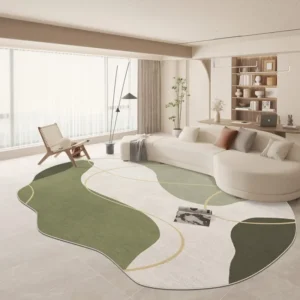 Large Area Green Rugs for Bedroom Nordic Living Room Decoration Shaped Carpet Irregular Plush Lounge Rug Home Thick Washable Mat
Rated 5.00 out of 5$54.94 – $346.41Price range: $54.94 through $346.41
Large Area Green Rugs for Bedroom Nordic Living Room Decoration Shaped Carpet Irregular Plush Lounge Rug Home Thick Washable Mat
Rated 5.00 out of 5$54.94 – $346.41Price range: $54.94 through $346.41 -
 Nordic Style Rugs for Bedroom Morandi Living Room Decoration Carpet Large Area Geometry Lounge Rug Home Cloakroom Non-slip Mat
Rated 5.00 out of 5$39.46 – $597.66Price range: $39.46 through $597.66
Nordic Style Rugs for Bedroom Morandi Living Room Decoration Carpet Large Area Geometry Lounge Rug Home Cloakroom Non-slip Mat
Rated 5.00 out of 5$39.46 – $597.66Price range: $39.46 through $597.66 -
 Irregular Shapes Living Room Decoration Carpet Modern Style Rugs for Bedroom Home Thicken Plush Rug Fluffy Soft Lounge Floor Mat
Rated 4.83 out of 5$55.84 – $347.37Price range: $55.84 through $347.37
Irregular Shapes Living Room Decoration Carpet Modern Style Rugs for Bedroom Home Thicken Plush Rug Fluffy Soft Lounge Floor Mat
Rated 4.83 out of 5$55.84 – $347.37Price range: $55.84 through $347.37

